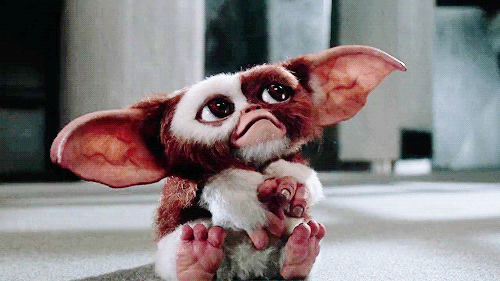In the
movie Gremlins, the furry Mogwais captured our hearts with their adorable little hands and large eyes. I expect
everyone that has ever seen that movie has desired one as a pet. I know I did. Their
care requirements seem very lax as well. Don’t give it water or bath it. Don’t
put it in direct sunlight. Don’t feed it after midnight. But that desire for a
Mogwai likely disappeared once you realized the reason why these rules are so
strict. Sunlight kills them. Water makes them multiply. And feeding them after
midnight causes them to transform into blood-thirsty Gremlins that will
continue to multiply and destroy everything in sight.
I
believe that a Mogwai is a great case study for Cohen’s Thesis III. He states
that monsters are “disturbing hybrids whose externally incoherent bodies resist
attempts to include them in any systematic structuration” (Cohen, p.6). Resembling
a goblin, a Mogwai’s form sits between adorable and monstrous. In its normal rodent
or ape-like state, a Mogwai warms our hearts and cheers us up with its delightful
voice (remember that well known scene in Gremlins
when Gizmo sings?). When touched by water, the replication of more Mogwai from
their back seems like something more alien. And when they are fed after
midnight, a Mogwai turned Gremlin appears more reptilian and predatory with
their scales and sharp teeth. Their questionable form does not categorize
easily. I think what Cohen is trying to prove with this thesis is that a
monstrous being is uncategorizable, and thus clashes with the order of our world.
A monster represents the collision of extremes. In the case of a Mogwai (most
of them at least), its loving appearance clashes with its desire to become a Gremlin
and wreak havoc. Not fully understanding what this creature is or neglecting one’s
own responsibility in its care can cause chaos and disrupt the order of our
world.

I remember watching this movie a couple years ago, and was always bothered by the lesson I saw given, that curiosity will be punished, and that not following the rules will lead to horrible things. I think the reason it always bothered me is that a rule without a reason is just asking to be ignored. If you explain a rule, it gives someone a reason to follow it.
ReplyDeleteIn the case of the Mogwai, had it been explained why the rules needed to be followed, the movie would probably have been a lot shorter. Don’t get them wet or you’ll get more, and the son probably would have bought adorable little raincoats. Don’t feed them after midnight, or they will try to kill you, and they would probably avoid the bedtime snack. Even if these two rules hadn’t been explained, explaining that sunlight will solve the problems from the first two would have been a good start.
I think rules are important, but if you don’t explain the rules, they might not be followed, and it can lead to a lot more problems than taking the time to say why.